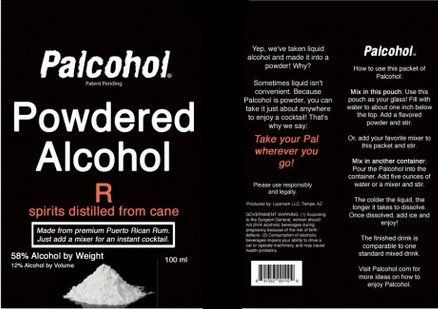
Palcohol -- powdered alcohol -- has passed U.S. Alcohol and Tobacco Tax and Trade Bureau requirements and could be on shelves as soon as this summer. However, at least a dozen states are proposing bans on Palcohol or have already done so. On Thursday, Senator Charles Schumer (D-NY) introduced a bill to ban powdered alcohol nationwide.
“I am in total disbelief that our federal government has approved such an obviously dangerous product,” he said in a statement.
So what is Palcohol, and what’s all the fuss about? Is it a dangerous new drug delivery system destined for disaster, or is powdered alcohol no more novel than powdered eggs (which are real, and really disgusting, by the way). Finally, regardless of it’s merits, will Palcohol go the way of Four Loko and get forced of the shelves?
Palcohol
Powdered alcohol comes in packet. Four flavors approved by the Feds imitate traditional cocktails like cosmopolitans and drinks like rum. Open the packet, pour the powder into water, mix it for a minute, and you’ve got a cocktail in your hand. If you’re an outdoors enthusiast looking for a convenient way to carry booze, or an airline passenger looking to get cheap drinks on your flight, powdered alcohol might help you get your fix.
We’ve already written about how we think palcohol is a bad idea. But founders argue that aside from weight and transportability, alcohol is fundamentally the same whether in powder or liquid form. Plus, says palcohol creator Mark Phillips, there’s no justification in prohibition.
“We don’t need a nanny government telling us what we can drink,” said Phillips, on CBS Morning. On his website, Phillips addresses concerns about the product, from potential snorting to smuggling.
Four Loko
Tell that to creators of Four Loko, an alcoholic energy drink that changed it's formula in 2010 after mounting pressure from colleges and the FDA. To many, Four Loko seemed innocuous, a conveniently pre-packaged cocktail of booze and caffeine in an era when vodka/RedBulls were already fueling parties across the country. For others, Four Lokos were an abomination that needed to be stopped. Here’s California State Senator Alex Padilla (D-Pacoima) on a bill he passed which outlawed the drink statewide.
"The added caffeine masks the effects of the high alcohol content, which can lead to binge drinking and dangerous behavior,” Padilla said, quoted in an LA Times blog.
That dangerous behaviour was embodied by college students, whose out-of-control embrace of the drink caused a spike, or at least a perceived spike, in alcohol poisonings. Dozens of universities banned the drink in 2010. Months later, the FDA announced that it had deemed Four Loko and similar drinks were unsafe.
The Importance Of Portion Size
At the center of opponents arguments was that the most alcoholic and most caffeinated Four Loko held the equivalent of 4.7 cans of beer and two Red Bulls. When you bought a can of Four Loko, you were committing to a very serious night. A competitive frat boy buying two or three was committing to a very dangerous one. A similar issue could arise for the producers of palcohol.
What the Four Loko ban argument rarely mentioned was that the can was over 23 ounces. The alcohol by volume (8 to 12 percent) was between that of strong beer and light liquor, while the caffeine content was on par with an 8oz cup of starbucks.
Assuming that the debauchery spike was real, it might have been due to the large portion size of Four Loko. It’s a lot like the debate over selling large sodas in New York City.
"The data clearly shows people who are given large portions consume more without realizing it and if you shrink portions they consume less but still feel satisfied," said Kelly Brownell, a professor of psychology and epidemiology at the department of health at Yale University, in an article by ABC News.
Bronwell’s comments concerned sodas, but portion sizes were an issue with Four Loko as well.
"We had this episode a few years ago with fortified sweet [alcoholic] drinks," said Dr. Kennon Heard, a toxicologist at the University of Colorado, in an interview with CBS. "Younger people who did not know the products were drinking them and getting intoxicated much faster."
With palcohol, consumers mix their own alcohol in portion they choose. Take palcohol’s rum mix, which is supposed to be mixed with 200mg of water or juice for a 10 percent alcohol by volume (ABV) drink. Thinking again of the many competitive frat boys and girls that I shared air with in college, I can almost hear them say “let’s mix palcohol with a Four Loko.”
Additionally, the powder itself is 55 percent ABV. Even cutting out intentional misuse, that level of toxicity is enough to confuse the volumetric instincts of drinkers, especially those who are inexperienced or already tipsy. Some states already prohibit or additionally regulate drinks with 80 percent or more ABV (which can be used for mixing, cleaning, or setting things on fire), partially because they were misused by college students.
It might not seem fair to the producers of palcahol, but misuse by a few will have serious consequences on the debate, just as it did with Four Loko. Right now they plan to sell their drinks in single-serve packets. With ethical marketing and pragmatic packaging (no family size!), they might prevent an all-out ban. They might even consider making it really expensive, to keep students -- and politicians -- away.
Revisions: this article was revised on 3/18 to clarify that Four Loko was not banned by any government agency, but rather by college campuses. According to Phusion Projects, the maker of Four Loko, the company "voluntarily reformulated Four Loko in 2010 to remove caffeine, guarana and taurine." And "began producing the reformulated version of Four Loko on November 18, 2010 and haven’t made the product with those ingredients since then."
© 2025 Latin Times. All rights reserved. Do not reproduce without permission.



